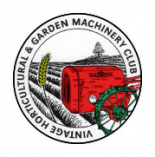Forum Replies Created
-
AuthorPosts
-
January 23, 2014 at 9:18 am #5375
 hillsiderParticipant
hillsiderParticipantI think there must be a rule about sheds and workshops, they are almost always full to capacity soon after moving in. I know that has ben the case with both of mine.
Ray.January 23, 2014 at 9:11 am #5374 hillsiderParticipant
hillsiderParticipantSounds a good idea re the washing line, make sure it is good strong line though or your freshly painted parts could take tumble! Some of the plastic coated line used on rotary clothes lines looks pretty but I would not want to trust it with any weight on it.
January 16, 2014 at 9:27 pm #5179 hillsiderParticipant
hillsiderParticipantThat’s ok, But I think it would not be a bad idea to keep a lookout for another deck to perhaps salvage a spare housing from if you intend to keep the machine in work.
It seems that although aluminium is very corrosion resistant if it does suffer it suffers badly.
Ray.January 16, 2014 at 7:14 pm #5176 hillsiderParticipant
hillsiderParticipantI don’t wish to upset you here but the housing shown in image 3 appears to have severe wastage of the Aluminium casting, some of those pitted areas must be near or over 50% of their original thickness and given the nature of the decay I would be wondering if there is enough strength left in the housing to support the blade when under load.
The general rule for material wastage on steelwork, bolts and components etc was 10% maximum when I was last involved in mechanical inspections.
Ray.January 10, 2014 at 6:49 pm #5024 hillsiderParticipant
hillsiderParticipantYou are correct about using Okum and Pitch to caulk timbers but don’t think it would be much use as an anti seize paste.
January 10, 2014 at 5:34 pm #5016 hillsiderParticipant
hillsiderParticipantProbably not allowed to use it now as at least one of the ingredients is banned but we used to use White Lead and Tallow for sealing and preventing corrosion on stern tube bearings and rudder bearings and Hull fittings etc. This or Red Lead mixed up into a paste with linseed oil was also used on Dock gate seals and other areas that were prone to being submerged in the sea.
Ray.January 10, 2014 at 10:37 am #5005 hillsiderParticipant
hillsiderParticipantLike our colleague wristpin I must hold my hand up as someone who has used Copper based anti seize compounds on Aluminium threads and has never noticed any ill effects. I see that Molyslip provide a product named Alumslip for jobs where the presence copper is not wanted but they don’t specify when that might be.
My biggest battle over the years has been trying to persuade people who should have known better that copaslip type products should not be used as the primary lubricant when assembling bearings/bushes.
Here are links to data sheets for two products that I have used successfully for years.https://www.molyslip.co.uk/anti_sieze_compounds/
https://www.lubadmin.com/upload/produit/FichePDF/lang_1/408.pdf
January 5, 2014 at 12:15 pm #4887 hillsiderParticipant
hillsiderParticipanthttps://www.forktruckspares.com/index.php
While looking for a company in Wales that I used to source pallet truck parts from I stumbled across the company above they look more promising as a source of parts/info than the company that I was looking for.
ray
January 3, 2014 at 4:57 pm #4805 hillsiderParticipant
hillsiderParticipantThe forum will go quiet this evening then if we are all watching James May’s Toy Story.
January 1, 2014 at 12:48 am #4687 hillsiderParticipant
hillsiderParticipantHappy new year to all from Kent.
December 30, 2013 at 5:36 pm #4641 hillsiderParticipant
hillsiderParticipantI have seen these mowers advertised before and there is no denying the standards that they are restored to, but I can’t help wondering if they have actually sold any mowers at these prices?
December 25, 2013 at 9:24 am #4500 hillsiderParticipant
hillsiderParticipantThink this may be the tool you describe, it is used to spread the links of the older style rubber and canvas link belt. Otherwise known as Brammer belt if I remember correctly.
Driving a simple cooling fan on your Dennis is a good example of an application for link belt, not too much load to make it stretch but often difficult to fit a new belt without disconnecting pump drive shafts etc. However we found that on a Massey Ferguson industrial loader that we used to run the load from the generator caused the belt to need constant adjustment, so we bit the bullet and fitted two of the correct belts to the machine – one in use and one tied back out of harms way as a spare.December 24, 2013 at 9:17 pm #4492 hillsiderParticipant
hillsiderParticipanthttps://www.asap-supplies.com/marine/link-belts-v-belts-vee-belts-polyvee-belts
The link above will let you see what link belting looks like, it is known as Nu-T-Link belt and it locks together using T shaped rivets that can be turned 90 degrees to lock or release the individual links. If I remember correctly this type of belt is directional when mounting it on the pulleys also it stretches like elastic under load, the bright orange type is much stronger in this respect though.
Re the Atco project I think you will need to fit a pulley on to the engine shaft for the drive belt to be driven from. As with rubber vee belts Nu T Link also takes its drive from the sides of the vee, in fact you will see that there is a neat row of rivet heads around the inner face of the belt that would prevent the belt gripping on a flat surface.
Hope this helps
Ray.December 24, 2013 at 11:21 am #4470 hillsiderParticipant
hillsiderParticipantBest wishes to you also Rob.
Ray.December 23, 2013 at 10:19 pm #4433 hillsiderParticipant
hillsiderParticipantThere was indeed a County Seahorse tractor that made the channel crossing in 1963. I don’t know if it landed in here Dover or just along the coast at St Margarets Bay I seem to think it may have been the latter of the two.
-
AuthorPosts

